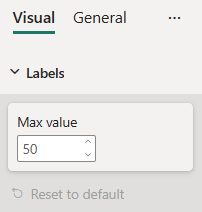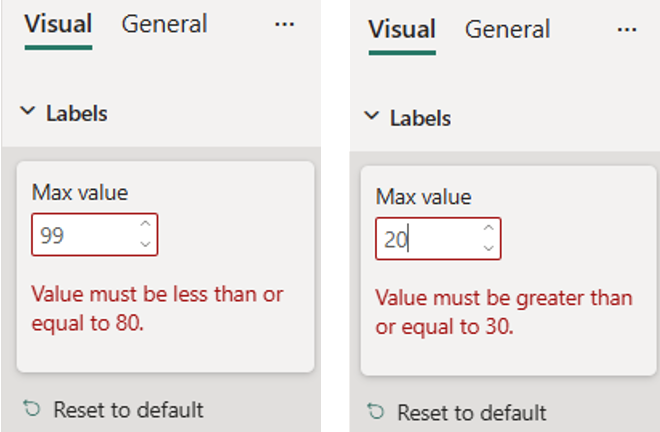ชิ้นการจัดรูปแบบของ NumUpDown

ตัวอย่าง: การใช้งาน NumUpDown
ในตัวอย่างนี้ เราจะแสดงวิธีการสร้าง NumUpDown แบ่งส่วนโดยใช้ยูทิลิตี้แบบจําลองการจัดรูปแบบ
วัตถุ Capabilities
แทรกส่วนย่อย JSON ต่อไปนี้ลงในไฟล์ capabilities.json
{
// ... same level as dataRoles and dataViewMappings
"objects": {
"labels": {
"properties": {
"max": {
"type": {
"integer": true
}
}
}
}
}
}
การจัดรูปแบบคลาสแบบจําลอง
แทรกส่วนย่อยของโค้ดต่อไปนี้ลงในไฟล์การตั้งค่า
import { formattingSettings } from "powerbi-visuals-utils-formattingmodel";
class LabelsCardSetting extends formattingSettings.SimpleCard {
name: string = "labels"; // same as capabilities object name
displayName: string = "Labels";
public maxValue : formattingSettings.NumUpDown = new formattingSettings.NumUpDown({
name: "max", // same as capabilities property name
displayName: "Max value",
value: 50
});
public slices: formattingSettings.Slice[] = [ this.maxValue ];
}
export class VisualSettings extends formattingSettings.Model {
public labels: LabelsCardSetting = new LabelsCardSetting();
public cards: formattingSettings.SimpleCard[] = [this.labels];
}
ตัวตรวจสอบความถูกต้อง (ไม่บังคับ)
คุณสามารถตรวจสอบ NumUpDown แบ่งส่วนข้อมูลได้โดยการระบุตัวเลือก คุณสมบัติ ตามตัวอย่าง:
import powerbi from "powerbi-visuals-api";
import { formattingSettings } from "powerbi-visuals-utils-formattingmodel";
class LabelsCardSetting extends formattingSettings.SimpleCard {
name: string = "labels"; // same as capabilities object name
displayName: string = "Labels";
public maxValue : formattingSettings.NumUpDown = new formattingSettings.NumUpDown({
name: "max", // same as capabilities property name
displayName: "Max value",
value: 50, // default slice value
options: // optional input value validator
{
maxValue: {
type: powerbi.visuals.ValidatorType.Max,
value: 80
},
minValue: {
type: powerbi.visuals.ValidatorType.Min,
value: 30
}
}
});
public slices: formattingSettings.Slice[] = [ this.maxValue ];
}
ข้อความเตือนจะปรากฏขึ้นถ้าค่าที่ส่งผ่านอยู่นอกช่วงที่ยอมรับได้
